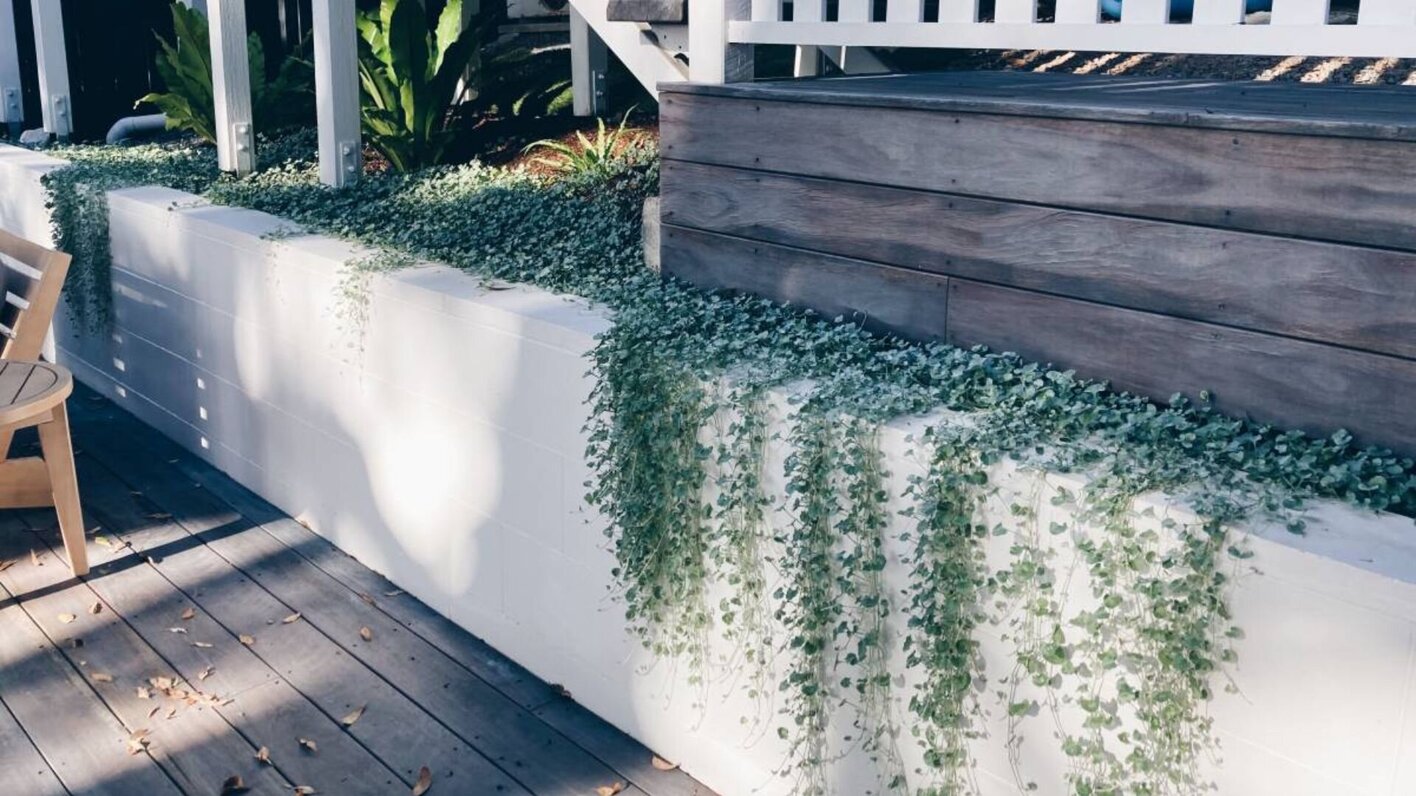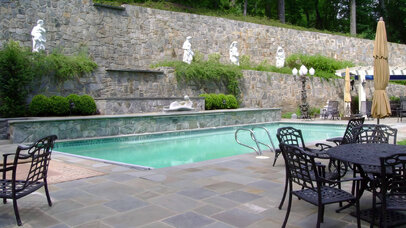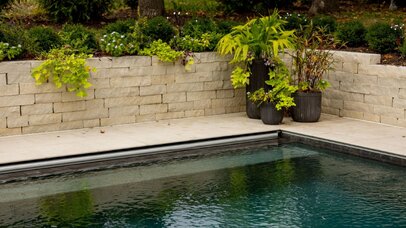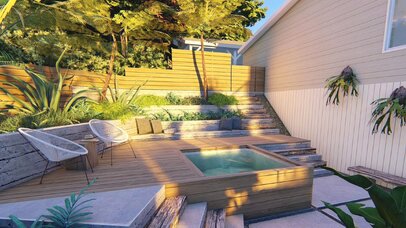The ultimate backyard oasis is a sparkling pool surrounded by a beautifully stacked retaining wall. But for many pool owners, taking on such a landscape project seems daunting.
Where do you begin building a functional retaining wall around your pool? Though it may appear complicated, creating your own stunning pool wall is very achievable, even for total DIY beginners.
With the right planning, materials, and techniques, you can construct an eye-catching pool retaining wall and unlock your landscape design dreams. This step-by-step beginner’s guide will walk you through the entire process, from layouts to capstones.
We’ll explore choosing the best wall materials, excavation and prep work, proper building methods, and finishing touches. With helpful tips for each phase, you’ll gain the knowledge and confidence to turn your pool area into a relaxing haven.
Follow our beginner-friendly pool wall instructions to save money, add beauty, and boost your landscaping skills. Let’s get started on maximising your backyard oasis!
Planning Your Pool Retaining Wall
The key to a successful DIY pool retaining wall project is proper planning from the very start. First, thoroughly measure the area where you want to build the wall and map out potential layouts that work with your space.
Consider the overall length, height, shape, and aesthetic you want. Research your soil type and drainage to account for ground stability and water flow.
Decide if you need local permits for walls over 4 feet high. With a well-thought-out design plan tailored to your poolscape area and needs, you’ll set the foundation to construct an eye-catching, functional retaining wall that complies with codes.
Higher walls mean water features! If you want to go above and beyond with your design, creating a water feature with your retaining wall is that creative extra step. Consulting a landscape professional is recommended for guidance on planning more complex pool wall projects as a beginner.
Selecting Materials
When building your own pool retaining wall, one of the most important decisions is choosing the right materials. Popular options include concrete blocks, natural stone, bricks, wood timbers, and poured concrete.
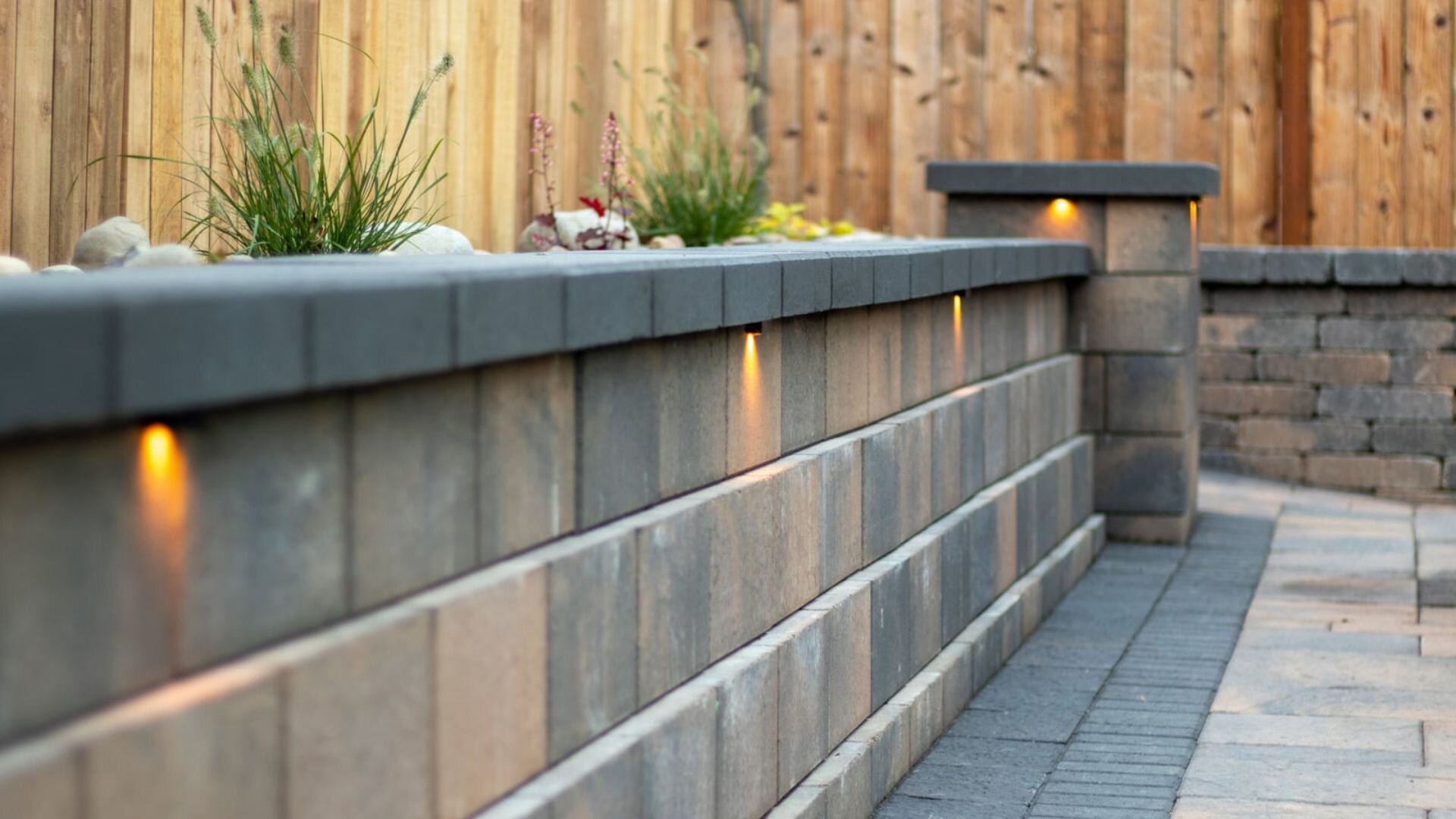
Consider the pros and cons of each in terms of durability, retaining walls cost, appearance, and difficulty to install for a DIY beginner. For example, poured concrete offers the most strength but requires building forms.
Retaining walls can be expensive but crucial for pools installed in sloped yards and spaces. If you have a sloped yard, a retaining wall pool is the best pool for your budget.
If you have a perfectly flat and even backyard space, you won’t need a retaining wall for the pool. The final retaining wall cost will depend on a wide range of different factors.
Natural stone has a beautiful look but can be more expensive and time-consuming to install. Concrete blocks are affordable, readily available, and do not require special construction skills. The idea is to select materials that meet your budget and match the surrounding pool aesthetics. With the right materials, you’ll be able to create a stunning pool wall that lasts.
Prep Work and Excavation
Once you’ve finalised the design plan, the real construction process begins with thorough prep work and excavation. Mark out the wall layout and dig a trench at least 2 feet deep and wide enough for a sturdy base.
Add crushed gravel and compact it to form a level foundation. Install drainage piping and backfill material if needed before the building begins.
Proper soil reinforcement and drainage now will prevent the wall from settling or eroding later. Measure and excavate to precise dimensions following code requirements.
Prepping the site with care and attention is imperative for constructing a sound, lasting pool wall. Take it slowly and steadily to create the framework to support the structure.
How to Build a Pool Retaining Wall
Now that you’ve completed the excavation and prep work, it’s time to start actually building a retaining wall. Follow these key steps to construct your DIY pool wall from the ground up properly.
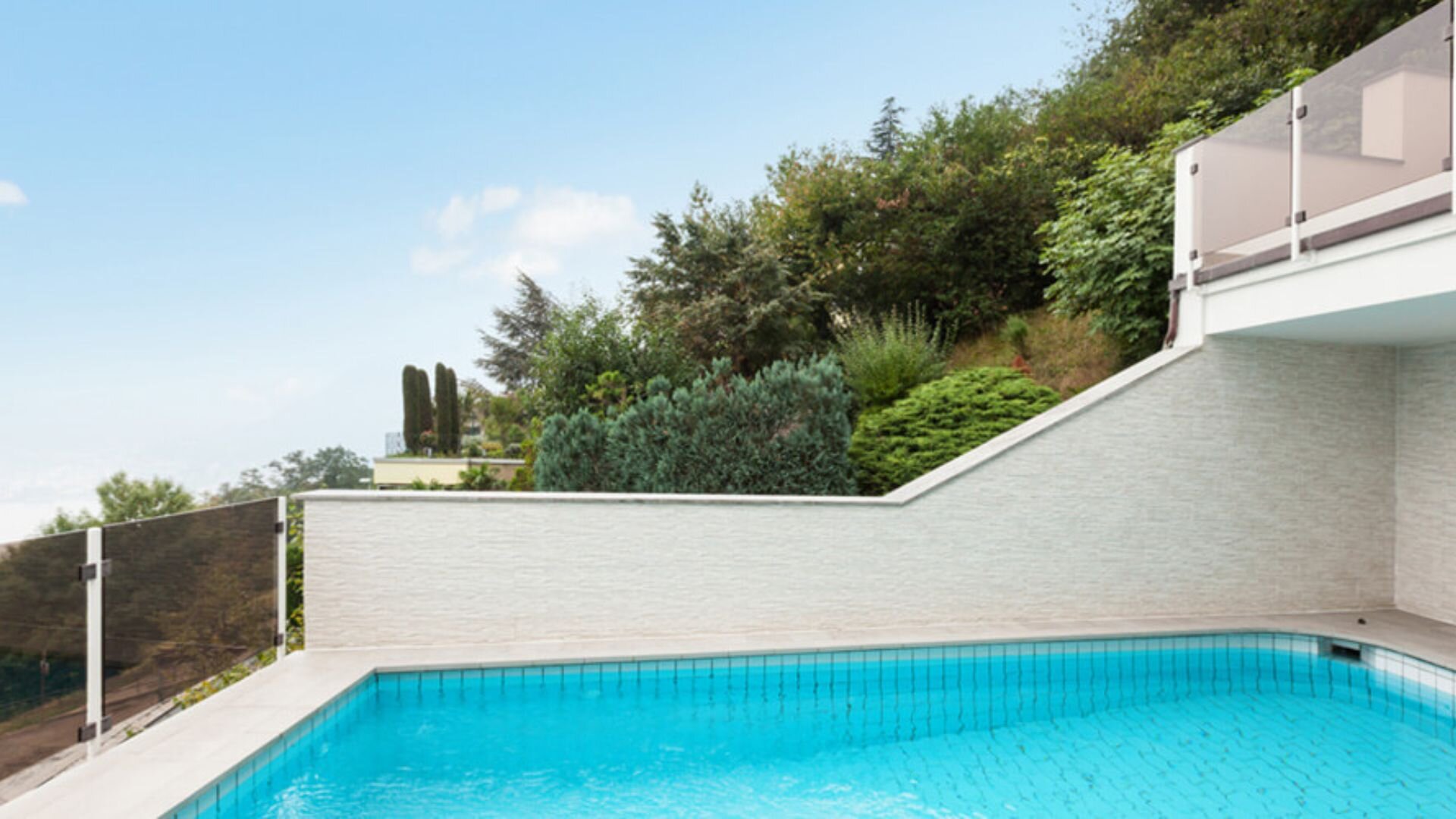
Laying the base course
The base course establishes the foundation and stability for the entire retaining wall. Place the first row of blocks lengthwise into the trench, levelling and aligning them both horizontally and vertically. Use a plate compactor to settle the blocks into the gravel base. Check your levels frequently using a long straightedge. This initial row must be perfectly level and smooth.
Stacking additional courses
Stack the second row of blocks closely up against the base, offsetting the seams in a bricklay pattern. Use construction adhesive between tiers for added strength. Check level and alignment as you go. Repeat staggered stacking to the desired height, alternating block textures and colours for visual appeal.
Inserting reinforcement as needed
For walls higher than 3 feet, reinforced with grid or lattice. Layer geosynthetic fabric and fill cores with gravel regularly per product instructions. This provides drainage and added structural support. Tie in reinforcement grids with wall blocks.
Backfilling with gravel
Backfill inside and behind the wall with free-draining gravel as you build up. Compact it in 8-inch layers. Proper backfill prevents erosion and keeps everything anchored securely. Take care not to shift wall blocks during this process.
Finishing Touches
The final and rewarding stage is adding those special finishing touches. Cap off the top of the wall with a row of coping or decorative wall caps to complete the structure and achieve a streamlined look.
Consider applying waterproof sealants or accent colours with masonry paints or stains, allowing 2-3 days to cure properly. Now is the time to install fencing, lighting, planters, or any embellishments to showcase your beautiful new retaining wall.
Incorporate curved accents, tile insets, rock clusters, or cascading plants for added wow factor. With the right finishing details tailored to your pool area, you can showcase both the functionality and aesthetic appeal of your DIY pool retaining wall. Take time to admire your handiwork and enjoy a gorgeous new backyard pool.
Ongoing Care for Your Retaining Wall’s Longevity
Installing a beautiful retaining wall or poolscape is an investment that requires some periodic maintenance and care to maximise its lifetime and function. With proper upkeep, your well-built retaining wall can look pristine and fully serve its purpose for decades.

Maintaining Drainage Components
To prevent clogging or blockages, it’s essential to routinely inspect and clear all drainage components associated with the retaining wall. Proper drainage is key to reducing hydrostatic pressure and erosion, so keeping drainage paths flowing freely is crucial. Clear out any debris or sediment build-up in weep holes, drain pipes, gravel backfill zones, catch basins, and outlets.
Checking for Signs of Wear or Damage
During heavy rains and seasonal changes, examine the wall closely for any shifting, bulging, cracking or crumbling sections that need repair. Watch for soil erosion around or behind the wall. Also, look for vegetation like vines or tree roots growing in the wall, which can exacerbate structural issues.
Getting Annual Professional Inspections
While periodic DIY checkups are wise, having a qualified landscaping contractor inspect your retaining wall once a year is smart. They can detect subtle problems like soil movement or small cracks that may lead to bigger issues if left unaddressed. Their expert eye may catch things you don’t notice.
Re-Applying Protective Sealants
Some retaining wall materials like natural stone or concrete blocks benefit from a protective sealer, which helps prevent staining or cracking. Re-apply these sealants as needed per manufacturer specifications, usually every 1-3 years. This preserves the wall’s aesthetic appeal.
Replacing Damaged Sections Promptly
Modular block retaining wall systems make it fairly simple to replace a damaged section. Remove and replace damaged blocks as soon as you notice them to prevent bigger failures. Keep extra blocks on hand for repairs.
Keeping Backfill Soil Level
Ensure the backfill soil behind the wall stays properly graded and compacted. Settling soil can create too much pressure. Remove any accumulated debris and re-level backfill as needed to maintain drainage.
By taking the time to properly care for your retaining wall and attending to any issues immediately, you can keep it structurally sound and looking like new. Consistent light maintenance makes for lasting wall performance.
DIY Pool Walls Made Easy
You can create a stunning DIY pool retaining wall with proper planning, prep work, construction, and finishing steps now under your belt. This beginner’s guide equips you with the key techniques and insights to turn your poolscape dreams into a reality. While building a pool wall has challenges, breaking the process into manageable stages makes the project approachable even for total novices.
The rewards of a breathtaking new backyard oasis are well worth the effort. So don’t hesitate to try your hand at a pool retaining wall—you can handle more than you think! For further guidance or to bring your vision to life, contact the experts at The Pool Co. Our team offers custom retaining wall pool installation services, saving you time while ensuring proper engineering and build quality. We can build retaining walls for pools in all areas of Sydney.
With a sparkling new pool surrounded by beautiful pool retaining walls, you can enjoy an outdoor paradise without leaving home. Refresh and relax in your personal backyard resort. Your swimming pool retaining wall awaits—let’s get building!
FAQs
What type of materials can I use to build a pool retaining wall?
The most common DIY pool retaining wall materials are concrete blocks, poured concrete, brick, stone veneer, or pressure-treated lumber. Concrete blocks are the easiest for beginners to work with.
How do I prepare the base for a retaining wall?
Excavate at least 2 feet deep and 8-12 inches wide. Fill with compacted gravel and level using a tamper. The trench should have a slight backward slope to facilitate drainage. Install perforated drainage pipes near the bottom. Backfill over pipes with more gravel.
How do I determine the height I need for my retaining wall?
Calculate the height by taking the difference between the ground level behind the wall and the desired pool water level. Add 12-24 inches as a safety factor. An engineer can help specify the required height if the site has drainage issues.
What is the most important part of building a pool retaining wall?
Proper foundation and drainage. Excavate a trench at least 2 feet deep and fill it with crushed gravel for drainage. Level and compact gravel before starting the blocks. The wall must sit on solid, undisturbed ground. Install drainage pipes behind the wall to direct water away from the pool.
What type of foundation do I need?
Pour a reinforced concrete footing under the first course of blocks to evenly spread the weight. The footing width depends on wall height - typically 6 inches wider than the blocks. The depth is usually 6-12 inches. Let it cure completely before starting the wall.
What techniques make a strong retaining wall?
Stagger joints between blocks and alternate course bonding patterns for strength. Use adhesive or mortar between block layers. Insert rebar into concrete block cells and fill with concrete. Backfill behind the wall in layers and compact well. Cap the top course to protect it from erosion.
How much space should I leave between the pool and the wall?
Leave at least 8-12 inches between the pool structure and wall. This allows space for drainage gravel and prevents pool water from saturating the soil behind the wall.
